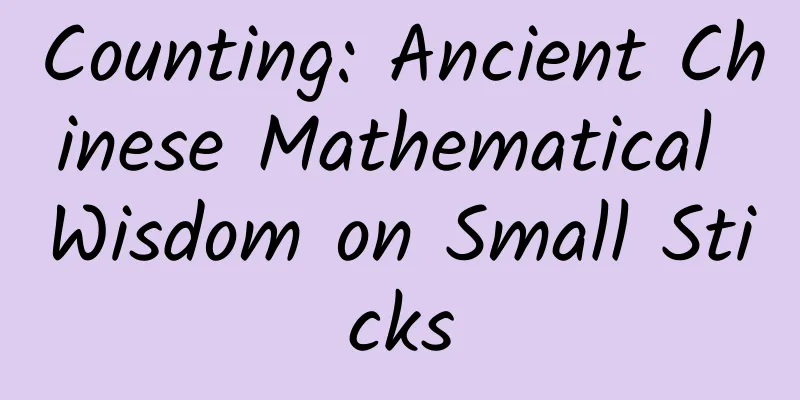Counting: Ancient Chinese Mathematical Wisdom on Small Sticks

|
The numbers that seem simple to modern people are actually the result of tens of thousands of years of human mathematical development. How to express and record numbers and what base to use directly determine the way mathematical operations, applications, and even records are passed down. Arabic numerals have the advantages of clear carry and easy writing, and have become the universal counting symbols in the modern world. Arabic numerals were actually invented by Indians, and got their name because they were introduced to Europe by Arabs. Academic circles call them Indian-Arabic numerals. Before the Indians invented this, China had developed a practical and complete counting system - the counting method of counting rods. China pioneered the decimal system of numbering Zou Dahai, a researcher at the Institute of the History of Natural Sciences of the Chinese Academy of Sciences, said that counting rods were a common calculation tool in ancient China, also known as calculation, counting rods, strategy, counting strategy, and operator. Using counting rods to count and calculate and the corresponding methods are called counting calculation. Counting calculation is a feature of ancient Chinese mathematics. In ancient times, Chinese mathematics was the representative of East Asian mathematics and had distinct characteristics in the history of world mathematics. Zou Dahai believes that compared with ancient mathematics in other regions, ancient Chinese mathematics excelled in calculation and algorithm. One of the main reasons for this is the widespread use of counting rods, which not only produced an advanced numeral system, but also a set of methods for expressing unknown quantities and algebraic expressions, which realized the function of algebraic symbols in a unique way. The number system is one of the basic concepts in mathematics, which means "accumulating several basic units to form the next unit." The number systems that people are more familiar with include the most common decimal system, the sexagesimal system used for time and angle measurement, and the binary and hexadecimal systems commonly used in the computer field. On the basis of the number system, the concept of positional value was developed, that is, the position of the number can represent the multiple of the corresponding digital unit. For example, in the Arabic numerals 5234, 5 is in the "thousand" position, representing 5 thousands, while 2, 3, and 4 are in the "hundred", "ten", and "one" positions, representing 2 hundreds, 3 tens, and 4 ones respectively. Many number systems do not have the concept of positional value. For example, the ancient Egyptian numerals are very cumbersome because they do not have the concept of positional value. Zou Dahai introduced that the decimal system was first seen in ancient Egypt; the positional system was first seen in the ancient Mesopotamian region, where people adopted a sexagesimal positional system; and the modern decimal positional system of counting originated in China. The Chinese adopted the decimal system very early, and the Chinese character numerical notation is the decimal system. One is both a basic number and a numerical unit. In addition, common numerical units include ten, hundred, thousand, ten thousand, hundred million, trillion, and kilometres. For example, the number "1 trillion, 853, 21, 888, 851" can be replaced by 0 in the empty digits and the digital units such as trillion, billion, ten thousand, thousand, hundred, and ten can be removed to become "1853020188851", which corresponds to the modern "1853020188851". It can be seen that the Chinese character counting method is quite advanced and can be easily converted to the popular Arabic numeral representation. However, the Chinese character representation method is only a quasi-decimal value system and is not yet perfect. The true decimal value system is the counting method of counting rods. Before the 14th century AD, counting rods were a widely used calculation tool, and then they were gradually replaced by abacus. The image of counting sticks is similar to that of chopsticks, which originated from the ancient people's habit of counting with long sticks. There are two forms of counting sticks to represent one to nine: vertical and horizontal. The Xiahou Yang Mathematical Classic says: "For numbers above six, five is on top, sixes are not counted cumulatively, and fives are not counted alone." This means that for numbers from one to five, use the same number of counting sticks as you want; for numbers from six to nine, place one counting stick on top to represent the five contained in it, and place the same number of counting sticks perpendicular to it below to represent the remaining number. For example, ╥ represents seven, one on top represents five, and two on the bottom represent two. For multi-digit numbers, Sun Zi Suan Jing records the counting rod method: "In any method of calculation, first know the position. One is vertical and ten is horizontal. One hundred is upright and one thousand is rigid. One thousand and ten are opposite each other. Ten thousand and one hundred are equal." The ancients used vertical method for ones, horizontal method for tens, vertical method for hundreds, and horizontal method for thousands, and so on. Zou Dahai emphasized that it would have been enough to use only one of the two methods, but the method of crisscrossing is clearer and not easy to mess up. The counting rod method was probably created during the Western Zhou Dynasty and the Spring and Autumn Period, or even earlier. Traces of this counting method can be seen on unearthed pottery fragments and coins from the pre-Qin period. Counting and calculation functions The addition and subtraction of counting rods is relatively simple, and the ancients did not record it. For complex multiplication and division, the ancients arranged counting rods in three rows, with the middle row being the product or dividend, the bottom row being the multiplier or divisor, and the top row being the multiplicand or quotient. By using the Nine-Nine Formula and the counting method of counting rods, the result can be obtained. This process is essentially very similar to modern vertical multiplication and division. Counting rods can also be used to solve linear equations. In the Nine Chapters on the Mathematical Art, which was written in the 1st century BC, a method called "equation" was used to express problems and solve them. Its expression and calculation methods are very similar to modern augmented matrices, and the augmented matrix method for solving linear equations did not appear in Europe until the turn of the 18th and 19th centuries. Zou Dahai introduced that in the equations of counting rods, different positions have the function of indicating different unknown quantities and constant terms, which is equivalent to the modern separation coefficient method. It is the equation that gave rise to the concept of positive and negative numbers. In ancient times, black and red counting rods were generally used to represent negative and positive numbers respectively. The Nine Chapters on the Mathematical Art also uses counting rods to extract square roots and cube roots, and to solve quadratic equations. This method continued to develop, and by the Song Dynasty, a set of methods for finding numerical solutions to higher-order equations with one variable had been formed. In the Song and Yuan dynasties, a general method for listing equations was also developed. First, the Tianyuan method for solving a single unknown quantity appeared, and later it developed into a method for listing and solving a system of higher-order equations with up to four unknown quantities - the Siyuan method, which uses heaven, earth, people, and objects to indicate unknown quantities. Zou Dahai emphasized that in the formulas listed by this method, except for counting rods and individual Chinese characters "太" or "元", no symbols are used, but the unknown quantity and its power are reflected by position, realizing the function of algebraic symbols, which is even more advantageous than modern symbolic methods in some aspects. In ancient China, the combination of writing and counting rods enabled the development and inheritance of mathematical work. With its powerful counting, symbol and calculation functions, counting rods played a significant role in the development of ancient Chinese mathematics. Later, with the development of commerce, the abacus calculation method and the corresponding formulas were developed, and then the abacus calculation was replaced by the abacus calculation. The abacus calculation plays a huge role in commerce, accounting and daily life by using and improving the formulas and methods of the abacus calculation. But counting rods also have their limitations. Zou Dahai pointed out that one of the shortcomings of counting rods is that the calculation process cannot be preserved, and it is difficult to trace if there is an error in the intermediate operation; the second is that counting rods take up a lot of space; and the third is that it is difficult to implement columns and operations with more than four elements. Planning to influence traditional Chinese culture In the Ming Dynasty, the Tianyuan method and the Siyuan method were lost, and counting rods were replaced by abacus and pen arithmetic, but their methods and ideas still play a role in the development of mathematics, and have even penetrated into all aspects of Chinese thought and culture. Zou Dahai emphasized that the importance of calculation lies in the formulation and use of a series of rules and methods. Calculation relies mainly on intelligence and pays special attention to precision, so many terms reflecting intellectual activities in traditional Chinese culture are related to calculation. For example, planning is called "yunchou" and "planning", and "yunchouweiwo, jueshengqianli" means that the commander planned well in the rear to win the front. For example, being thorough is called "calculating without missing a plan" and "having a plan in mind", while mistakes in planning are called "miscalculation" and "misstrategy". Other words such as "calculation", "secret calculation", "calculation", "fortune-telling", "win calculation" and so on, all originated from the ancient calculation thinking. "The ancients fully explored the positional function of counting rods, used counting rods to represent algebraic expressions, and designed corresponding calculation methods, forming the unique counting rod tradition in ancient China. Ancient Chinese arithmetic and algebra were once advanced and even leading in the world, which had a lot to do with counting rods. Counting rods are an important part of Chinese culture, and the thinking of counting rods has also had a certain impact on social culture and people's lives." Zou Dahai said. |
<<: Please don’t step on the grass! Is it okay to step on the grass?
Recommend
Free lunch is not delicious. Actual combat 360/Tencent free upgrade to Win10
Windows 10 has been officially released. I believ...
[A magic tool for watching movies anytime, anywhere] PaPa Pocket Cinema Review
Product highlights: small and portable, built-in ...
Electric vehicles frequently catch fire. Why can’t the safety of power batteries be guaranteed?
Recently, electric vehicles have caught fire freq...
Thump! Thump! Thump! Can I still exercise if my heart is beating fast?
Thump! Thump! Thump! Do you also sit and do nothi...
A collection of 13 essential tools for new media operations!
Thirteen categories of operation auxiliary tools ...
Creative material style for high-conversion information flow advertising on Toutiao!
Before talking about what are good creative mater...
Why are 60% of Japanese still going to work even though they are suspected of having COVID-19? Why are people still going to work when they are suspected of having COVID-19?
Why are 60% of Japanese still going to work even ...
Tian Xiusi's resume: What does the on-site optimization of Chongqing SEO optimization company include?
Now that the Internet industry is becoming more a...
Curved big screen is not enough Four TV games challenge TCL L55C1-CUD comprehensive performance
With the increasing popularity of smart TVs, play...
Detailed explanation of the 7 major factors, what influences the ranking of Baidu search results?
How can I make the information I publish appear o...
The debate over electric vehicle charging and battery replacement seems to have ended a little too early
There has always been a dispute over charging and...
Shocking: The top 10 most popular apps in the United States are owned by three major companies
The latest data released by Nielsen shows that th...
This "lotus leaf" is not actually a plant!
Speaking of "ceramics", there is no dou...
Saudi Aramco's market value tops the world's largest! Why is the Middle East so rich?
Saudi Aramco has become the world's largest o...
Qin Zhiqiang: How to sell virtual products and public account SEO on WeChat, and easily earn 10,000 yuan a month by working part-time at home
Two years ago, knowledge payment became popular, ...









